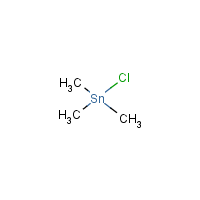Trimethyltin chloride
Agent Name
Trimethyltin chloride
CAS Number
1066-45-1
Formula
C3-H9-Cl-Sn
Major Category
Metals

Synonyms
Chlorotrimethylstannane; Chlorotrimethyltin; M&T Chemicals 1222-45; Stannane, chlorotrimethyl-; Stannylium, trimethyl-, chloride; Tin(1+), trimethyl-, chloride; Trimethylchlorostannane; Trimethylchlorotin; Trimethylstannyl chloride; [ChemIDplus] UN3146
Category
Tin Compounds, Organic
Description
Colorless solid; mp = 37.5 deg C; [HSDB] White crystalline solid; [MSDSonline]
Sources/Uses
A byproduct of methyltin manufacture; Used as an experimental pesticide; [HSDB]
Comments
In 1981, six employees in a chemical firm were exposed to trimethyltin chloride while working at the access opening of the reactor. All patients were hospitalized, and one patient died 10 days after the accident. Patients had headache, tiredness, hearing loss, disorientation, and other neurological symptoms. [HSDB] Of the trialkyltins, triethyltin and trimethytin are the most toxic. [ACGIH] An irritant; Can be absorbed through skin; [MSDSonline] See "Tin, organic compounds."
Biomedical References
Exposure Assessment
Skin Designation (ACGIH)
Yes
TLV (ACGIH)
0.1 mg/m3, as Sn
STEL (ACGIH)
0.2 mg/m3, as Sn
PEL (OSHA)
0.1 mg/m3, as Sn
MAK
0.005 mg/m3 (can also occur as vapor and aerosol)
IDLH (NIOSH)
25 mg/m3, as Sn
Explanatory Notes
The Guide in the Emergency Response Guidebook is for "Organotin compound, solid, n.o.s." Organic tin compounds have a "skin" designation and are classified as "A4" (Not classifiable as human carcinogen); [ACGIH]
Adverse Effects
Neurotoxin
Other CNS neurotoxin
Hepatotoxin
Hepatoxic (a) from occupational exposure (secondary effect) or (b) in animal studies or in humans after ingestion
ACGIH Carcinogen
Not Classifiable
Diseases, Processes, and Activities Linked to This Agent
Diseases
Occupational diseases associated with exposure to this agent: